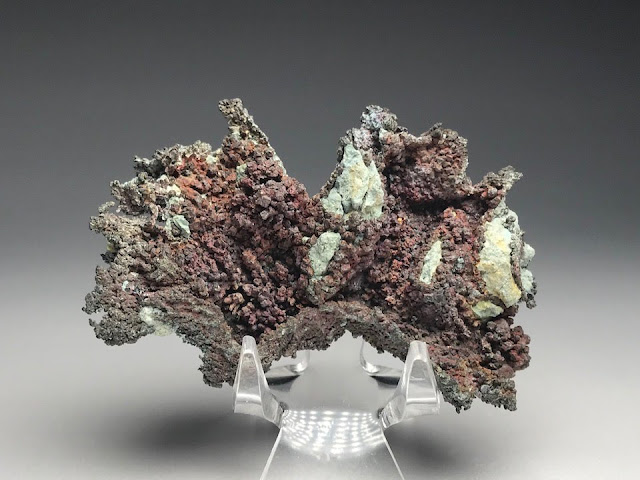尾去沢の自然銅 Native Copper from Osarizawa
秋田県鹿角市 尾去沢鉱山
Osarizawa Mine, Kazuno City, Akita, Japan
幅 width 60 mm / 重さ weight 50 g
銅の結晶が連結して蝶々のようなかたちになった。緑色の部分は母岩の破片。写真左端のあたりは、いわゆる樹枝状結晶を呈している。
秩父で自然銅の塊が発見されて、年号が「和銅」になったのが西暦708年。それよりずっと昔から、自然銅こそ金属を得るためのもっとも有用な鉱石であった。尾去沢のような熱水鉱脈型の鉱床の場合、まず地表近くの硫化鉱物が地下水や空気中の酸素と反応して硫酸を生じ、それが黄銅鉱を分解してさまざまな銅の2次鉱物をつくり、その過程で単体の銅が生成する。したがって自然銅は地表付近にあってしかるべきものであり、太古の人間にとっても利用しやすかった。逆に言うと、いまやそんな自然銅なんてものはとっくの昔に掘り尽くされており、簡単に見いだせるものではない。
Copper crystals gather to form a butterfly shape specimen. Green part is a fragment of country rock. A dendrite is seen in the left of the above picture.
In 708, the era name of Japan changed to Wado (Japanese copper) due to the finding of native copper in Chichibu. Native copper was the most useful ore for ancient people to obtain metals. In a hydrothermal deposit like Osarizawa, near surface sulfides generate sulfuric acid in the presence of water and oxygen, dissolving chalcopyrite into various secondary copper minerals including native copper. Therefore, copper naturally exists near the surface and is easily mined by ancient people. That also means that it is now difficult to find copper on the earth.

